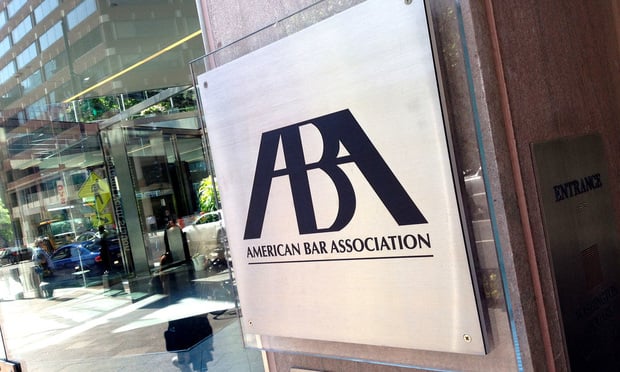Rutgers, Seton Hall Included in Law School Enrollment Jump, Per ABA Stats
New student enrollment at the nation's law schools increased 3 percent this fall, according to figures released by the American Bar Association, and New Jersey's two law schools are part of the trend.
December 20, 2018 at 09:00 AM
3 minute read
The original version of this story was published on Law.com
New student enrollment at the nation's law schools increased 3 percent this fall, according to figures released by the American Bar Association, and New Jersey's two law schools are part of the trend.
It's the first measurable increase in the size of the first-year class since 2010—when new enrollment peaked at more than 52,000. The number of new law students at ABA-accredited law schools fell 29 percent between 2010 and 2015, before leveling off at about 37,000 for the next three years. This fall, 38,390 new students showed up on campus, which is 1,070 more than the previous year, according to the figures release on Dec. 14.
At Rugers Law School, 2018 first-year enrollment increased 17.87 percent over 2017, to 409 from 347, according to the ABA.
At Seton Hall University School of Law, it was a 24.87 percent year-over-year increase, to 246 from 197.
Those appear to be among the better gains: of the roughly 200 listed schools, less than one-fifth of them had enrollment gains of 17 percent or higher, according to the figures.
More than half of schools—122—reported an increase in the size of their first-year class, while 81 schools told the ABA that their 1L class is smaller than in 2017.
The New Jersey schools didn't respond to request for comment.
The boost is welcome news for legal academics, who for years have hoped in vain for a turnaround in legal education's fortunes. Waning interest in a law degree forced many schools to reduce the size of their faculties and make other cutbacks. Five schools have closed in recent years or will soon shut down.
The 3-percent increase in new law students this year isn't unexpected. Applicants to law school surged 8 percent last year, according to the Law School Admission Council, fueling speculation that law school is once again a hot ticket. The Trump administration and discord in Washington are contributing to the added interest in legal education, according to deans and admissions officers.
Some schools appear to have utilized the larger applicant pool as an opportunity to be more selective about the students they admit, said Jerome Organ, a professor at the University of St. Thomas School of Law who studies enrollment trends. Put another way, schools opted to admit fewer students than they could have, given the increase in applicants in order to bring in classes with higher Law School Admission Test scores and undergraduate grades, he said.
Still, the boost in applicants caught some law schools by surprise. Some ended up with larger 1L classes than intended, which is a reversal from the days when admissions offices were scrambling to fill up seats.
It's not just J.D. programs that gained in popularity this year. Enrollment in non-J.D. programs, which includes LL.M. and masters programs, grew more than eight percent from 2017.
This content has been archived. It is available through our partners, LexisNexis® and Bloomberg Law.
To view this content, please continue to their sites.
Not a Lexis Subscriber?
Subscribe Now
Not a Bloomberg Law Subscriber?
Subscribe Now
NOT FOR REPRINT
© 2025 ALM Global, LLC, All Rights Reserved. Request academic re-use from www.copyright.com. All other uses, submit a request to [email protected]. For more information visit Asset & Logo Licensing.
You Might Like
View All


On the Move and After Hours: Buchanan; Malamut Law; Genova Burns; Faegre Drinker
3 minute read
Trending Stories
- 1Uber Files RICO Suit Against Plaintiff-Side Firms Alleging Fraudulent Injury Claims
- 2The Law Firm Disrupted: Scrutinizing the Elephant More Than the Mouse
- 3Inherent Diminished Value Damages Unavailable to 3rd-Party Claimants, Court Says
- 4Pa. Defense Firm Sued by Client Over Ex-Eagles Player's $43.5M Med Mal Win
- 5Losses Mount at Morris Manning, but Departing Ex-Chair Stays Bullish About His Old Firm's Future
Who Got The Work
J. Brugh Lower of Gibbons has entered an appearance for industrial equipment supplier Devco Corporation in a pending trademark infringement lawsuit. The suit, accusing the defendant of selling knock-off Graco products, was filed Dec. 18 in New Jersey District Court by Rivkin Radler on behalf of Graco Inc. and Graco Minnesota. The case, assigned to U.S. District Judge Zahid N. Quraishi, is 3:24-cv-11294, Graco Inc. et al v. Devco Corporation.
Who Got The Work
Rebecca Maller-Stein and Kent A. Yalowitz of Arnold & Porter Kaye Scholer have entered their appearances for Hanaco Venture Capital and its executives, Lior Prosor and David Frankel, in a pending securities lawsuit. The action, filed on Dec. 24 in New York Southern District Court by Zell, Aron & Co. on behalf of Goldeneye Advisors, accuses the defendants of negligently and fraudulently managing the plaintiff's $1 million investment. The case, assigned to U.S. District Judge Vernon S. Broderick, is 1:24-cv-09918, Goldeneye Advisors, LLC v. Hanaco Venture Capital, Ltd. et al.
Who Got The Work
Attorneys from A&O Shearman has stepped in as defense counsel for Toronto-Dominion Bank and other defendants in a pending securities class action. The suit, filed Dec. 11 in New York Southern District Court by Bleichmar Fonti & Auld, accuses the defendants of concealing the bank's 'pervasive' deficiencies in regards to its compliance with the Bank Secrecy Act and the quality of its anti-money laundering controls. The case, assigned to U.S. District Judge Arun Subramanian, is 1:24-cv-09445, Gonzalez v. The Toronto-Dominion Bank et al.
Who Got The Work
Crown Castle International, a Pennsylvania company providing shared communications infrastructure, has turned to Luke D. Wolf of Gordon Rees Scully Mansukhani to fend off a pending breach-of-contract lawsuit. The court action, filed Nov. 25 in Michigan Eastern District Court by Hooper Hathaway PC on behalf of The Town Residences LLC, accuses Crown Castle of failing to transfer approximately $30,000 in utility payments from T-Mobile in breach of a roof-top lease and assignment agreement. The case, assigned to U.S. District Judge Susan K. Declercq, is 2:24-cv-13131, The Town Residences LLC v. T-Mobile US, Inc. et al.
Who Got The Work
Wilfred P. Coronato and Daniel M. Schwartz of McCarter & English have stepped in as defense counsel to Electrolux Home Products Inc. in a pending product liability lawsuit. The court action, filed Nov. 26 in New York Eastern District Court by Poulos Lopiccolo PC and Nagel Rice LLP on behalf of David Stern, alleges that the defendant's refrigerators’ drawers and shelving repeatedly break and fall apart within months after purchase. The case, assigned to U.S. District Judge Joan M. Azrack, is 2:24-cv-08204, Stern v. Electrolux Home Products, Inc.
Featured Firms
Law Offices of Gary Martin Hays & Associates, P.C.
(470) 294-1674
Law Offices of Mark E. Salomone
(857) 444-6468
Smith & Hassler
(713) 739-1250







